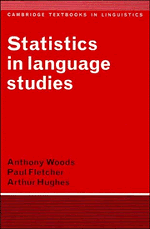Book contents
- Frontmatter
- Contents
- Preface
- 1 Why do linguists need statistics?
- 2 Tables and graphs
- 3 Summary measures
- 4 Statistical inference
- 5 Probability
- 6 Modelling statistical populations
- 7 Estimating from samples
- 8 Testing hypotheses about population values
- 9 Testing the fit of models to data
- 10 Measuring the degree of interdependence between two variables
- 11 Testing for differences between two populations
- 12 Analysis of variance – ANOVA
- 13 Linear regression
- 14 Searching for groups and clusters
- 15 Principal components analysis and factor analysis
- Appendix A Statistical tables
- Appendix B Statistical computation
- Appendix C Answers to some of the exercises
- References
- Index
10 - Measuring the degree of interdependence between two variables
Published online by Cambridge University Press: 05 June 2012
- Frontmatter
- Contents
- Preface
- 1 Why do linguists need statistics?
- 2 Tables and graphs
- 3 Summary measures
- 4 Statistical inference
- 5 Probability
- 6 Modelling statistical populations
- 7 Estimating from samples
- 8 Testing hypotheses about population values
- 9 Testing the fit of models to data
- 10 Measuring the degree of interdependence between two variables
- 11 Testing for differences between two populations
- 12 Analysis of variance – ANOVA
- 13 Linear regression
- 14 Searching for groups and clusters
- 15 Principal components analysis and factor analysis
- Appendix A Statistical tables
- Appendix B Statistical computation
- Appendix C Answers to some of the exercises
- References
- Index
Summary
In chapters 5 and 6 we introduced a model for the description of the random variation in a single variable. In chapter 13 we will discuss the use of a linear model to describe the relationship between two random variables defined on the same underlying population elements. In the present chapter we introduce a measure of the degree of interdependence between two such variables.
The concept of covariance
A study by Hughes & Lascaratou (1981) was concerned with the evaluation of errors made by Greek learners of English at secondary school. Three groups of judges were presented with 32 sentences from essays written by such students. Each sentence contained a single error. The groups of judges were (1) ten teachers of English who were native speakers of the language, (2) ten Greek teachers of English, and (3) ten native speakers of English who had no teaching experience. Each judge was asked to rate each sentence on a 0–5 scale for the seriousness of the error it contained. A score of o was to indicate that the judge could find no error, while a score of 5 would indicate that in the judge's view it contained a very serious error. Total scores assigned for each sentence by the two native English-speaking groups are displayed in table 10.1. One question that can be asked of this data is the extent to which the groups agree on the relative seriousness of the errors in the sentences overall.
- Type
- Chapter
- Information
- Statistics in Language Studies , pp. 154 - 175Publisher: Cambridge University PressPrint publication year: 1986
- 1
- Cited by



